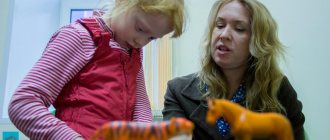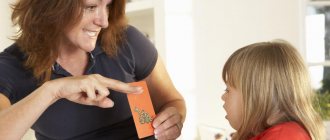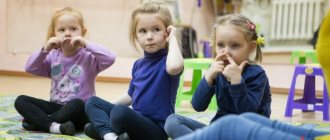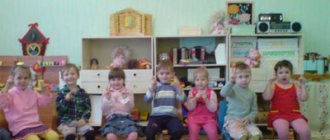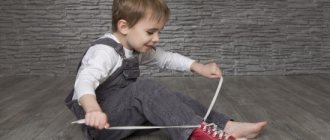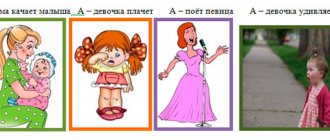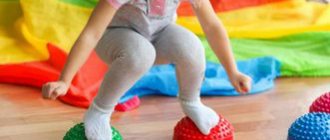Definition 1
Sensory education is ways of developing sensory perception of the surrounding world: determining the color, shape, size and other characteristics of objects that distinguish them from other objects.
Sensory education underlies the overall development of the younger generation. It is necessary for adequate knowledge of the structure of the surrounding world and its objects.
Sensory education of children with various speech developmental defects is especially important. This is due to the fact that speech disorders can be caused by deviations in the functioning of mental processes and brain function, and, consequently, deviations in sensory perception are observed. This leads to the need to build a special model of sensory education for children with speech defects.
Are you an expert in this subject area? We invite you to become the author of the Directory Working Conditions
Features of sensory development of a child with speech defects
Sensory development is important during the preschool years. It determines the effectiveness of preparing a preschooler for the next stage of his life - studying at school, since sensory development is responsible for the effectiveness of perception of the world around him.
Sensory development is realized throughout the preschool stage. At the same time, it has its own characteristics of development at different age periods.
As for children with speech defects, their sensory development differs in a number of specific features. These include:
- Reduced rate of perception of the surrounding world;
- Inaccurate perception due to malfunctions of visual and tactile perception caused by speech abnormalities;
- The study of objects in the surrounding world becomes lengthy and difficult. The study of objects is carried out on the basis of a number of practical actions, making a large number of mistakes;
- Untimely formation of standard ideas: difficulties in mastering shades of color, size parameters of objects: height, depth, length;
- A full-fledged image of an object, a holistic perception of its properties, is formed in the mind of a preschooler at a slow pace;
- Poorly developed ability to determine the properties of objects based on tactile perception: the child is practically unable to correctly form an idea of an object that he does not see;
- Difficulties in visual perception of objects in the surrounding world located in a non-standard environment;
- Spatial orientation problems that need to be quickly corrected.
Finished works on a similar topic
Course work Sensory education of children with speech disorders 410 ₽ Abstract Sensory education of children with speech disorders 220 ₽ Test work Sensory education of children with speech disorders 190 ₽
Receive completed work or specialist advice on your educational project Find out the cost
The sensory development of a preschooler with various speech pathologies becomes uneven. It lags behind its normal development and is not activated during sensitive periods. This requires the organization of an education system focused on the sensory development of a preschooler in the presence of one or another speech defect.
Model of sensory education for preschoolers with speech defects
Sensory education of children with various speech pathologies is implemented on the basis of a special program, including corrective measures to eliminate or smooth out speech disorders and enhance sensory perception.
The period of sensory learning for a child with speech disorders is longer and more labor-intensive. Children make many mistakes when naming the characteristics of objects. They cannot easily transfer the sensory patterns they have learned to real objects. This requires long-term practice and a large number of training exercises.
The model of sensory education for preschoolers with speech disorders can be presented as a process of cognition by a preschooler of the properties of objects through their perception in motion. This means that the motor analyzer is activated for perception. The process of perception becomes a real action implemented by the child to understand the properties of the object.
The perception of objects occurs in several stages:
- Conducting a visual inspection of the object: the child traces the outline of the object with his eyes.
- Having outlined the object visually, the child compares it with the forms that he knows and assigns this object to one of the forms.
- Dividing an object into parts and visual inspection, outlining the contours of each part.
- Determining the spatial location of each part of an object in relation to its underlying detail: located “above”, “to the left”, “to the right”, “to the side”, etc.
- Familiarity with the color scheme of an object and its parts. The child names the color of the entire object and each of its parts. If there is a predominant color, then it is worth noting, and also identifying all the colors and shades that the object has.
- Determination of the spatial orientation of the object in question.
This model is focused on the development of sensory perception in children with well-developed visual perception. If there are deviations in this area, then the contours of objects should be outlined using tactile perception.
Note 1
All classes are conducted in a playful way and include speech therapy correction of an existing speech defect.
www.Logopedy.ru
Authors: Belova Elena Vladimirovna - teacher-defectologist,
Raskatkina Elena Nikolaevna – teacher-speech therapist,
Kuznetsova Nina Arkadyevna - teacher-defectologist,
MBDOU combined type No. 45, Arzamas city, Nizhny Novgorod region
Original:
The main component of the full development of children is the development of sensory integration.
Sensory integration is the interaction of all senses. It begins very early, already in the womb. The interaction of all senses involves the ordering of sensations and stimuli in such a way that a person can adequately respond to certain stimuli and act in accordance with the situation. For example, sensory integration is observed when we feel the touch of a bug crawling on us, are aware of what is happening and know where it can be swatted. In other words, everything that we receive from the senses (and this is vision, hearing, touch, smell, taste, the sense of movement (vestibular system), the sense of body position in space (proprioception), enters the brain, is processed there, and is given to us in the form of some knowledge about an object - what it is, what properties it has and how dangerous it is for the body or, on the contrary, useful. The more correctly the sensory systems work, the more sufficient information the brain receives and produces more adequate responses.
The interaction of the five senses is sensory integration for preschoolers.
The sensory integration required for movement, speaking, and play is the foundation of the more complex integration that accompanies reading, writing, and appropriate behavior.
“Interesting” is the childish definition of sensory integration.
The creator of the sensory integration method is Jean Ayres , speech therapist, psychologist, occupational therapist, and researcher at the University of Southern California in Los Angeles.
Understanding the world around us begins with sensations, with perception. With the help of sensation, the child learns individual signs and properties of objects that directly affect his senses.
A more complex cognitive process is perception, which provides a reflection of all (many) signs of objects with which the child directly comes into contact and acts. The richer the sensations and perceptions, the broader and more multifaceted the information the child receives about the world around him will be.
It is known that the success of mental and physical education, and mastery of speech largely depends on the level of sensory development of children, that is, on how completely the child hears, sees, touches the environment, how well he handles this information and expresses this knowledge in speech. Sensory development in early and preschool children is closely related to sensory integration.
The process of cognition of a small person differs from the process of cognition of an adult. Adults understand the world with their minds, small children with their emotions. The cognitive activity of a 3-5 year old child is expressed primarily in the development of perception, the symbolic (sign) function of thinking and meaningful objective activity. In the process of developing perception, the child gradually accumulates visual, auditory, tactile-motor, and tactile images.
In this regard, one of the main tasks of children's activities is to develop interest in learning through sensory stimuli. It is necessary to organize children so that they want to do something, so that self-knowledge occurs, and motivation to speak appears.
In order for any concept, its name, to be fixed in the child’s memory, he must see, hear, taste and touch it. And only in this case is this connection formed in the brain. Nowadays there are many children in kindergartens who have some connection or some drop out. If for some reason the integration is weak and the brain cannot receive enough knowledge and give an adequate response, this can lead to problems with speech and general development.
In our preschool, along with ordinary children, children with disabilities are educated. In this category of children, there is an insufficiency in the process of processing sensory information ; often children cannot holistically perceive observed objects; they perceive them in fragments, highlighting only individual signs. All this complicates the process of correction and socialization.
We believe that one of the possible ways to solve this problem is to include elements of sensory integration into the overall system of correctional work.
The method of sensory integration in the work of a speech therapist, speech pathologist and psychologist involves stimulation of all senses and is aimed at activating cognition, all aspects of speech, and correcting behavior through sensory input.
This experiment presents a system of work to enrich children’s sensory experience, create connections in the brain through experimentation, games, subject-based practical activities, and create a specific developmental subject-spatial environment.
In our kindergarten there are 5 compensatory groups. Children have deficiencies in intellectual (developmental disabilities, intellectual disabilities) and speech (allalia, OSD, systemic underdevelopment of speech) development, motor disorders, behavioral characteristics of the autism spectrum, hyperactivity, difficulties in interacting with peers and adults. It is difficult for children to maintain attention on learning tasks, their interest is not stable, and there is often a lack of motivation for development.
In preschool age, great attention is paid to the development of the five basic senses - vision, smell, touch, hearing and taste.
A person receives the bulk of information about the world around him through vision.
Visual perception is a complex job, during which a large number of stimuli acting on the eye are analyzed. The more perfect visual perception is, the more diverse the sensations are in quality and strength, which means the more complete, accurate and differentiated the surrounding world is reflected. Impaired visual perception leads to difficulties in distinguishing objects (size, ratio of parts, differentiation of mirror or similar elements in configuration, etc.). Insufficient development of visual perception leads to a lag in the formation of spatial orientation.
Games that train visual perception develop observation, attention, memory, form an idea of color, shape, size, spatial arrangement of objects, and increase vocabulary.
Games with hiding, searching and finding, based on children's interest in the unexpected appearance and disappearance of objects, help train visual perception. Children are interested in looking for pictures at the bottom, under a thin layer of filler.
Games with sensory aids help to interest, distract, relax the child, ensure the most successful completion of a task, and develop mental and speech processes.
The ability not just to hear, but to listen, to focus on sound, to highlight its characteristic features is an exclusively human ability, thanks to which knowledge of the surrounding reality occurs.
Auditory perception begins with acoustic (auditory) attention and leads to an understanding of the meaning of speech through recognition and analysis of speech sounds, supplemented by the perception of non-speech components (facial expressions, gestures, posture).
The development of auditory perception proceeds in two directions: on the one hand, the perception of speech sounds develops, that is, phonemic hearing is formed, and on the other hand, the perception of non-speech sounds, that is, noise, develops.
Specially selected didactic games make it possible to act on a sound signal, learn to distinguish many objects and objects of the environment by characteristic sounds and noises, correlate one’s actions with signals, etc., and therefore correct deficiencies in auditory perception. At the initial stage, to distinguish non-speech sounds (as well as speech material) require visual, visual-motor, or simply motor support. This means that the child must see an object that makes some unusual sound, try to extract the sound from it in different ways, that is, perform certain actions. Additional sensory support becomes optional only when the child has formed the necessary auditory image.
Games for the perception of sound should give an idea of noises of different nature: rustling, creaking, squeaking, gurgling, ringing, rustling, knocking, birdsong, train noise, cars, animal cries, loud and quiet sounds, whispering, etc.
The development of visual and auditory concentration, attention to speech and its understanding is carried out in the process of the child’s cognition of objects and phenomena of the surrounding reality, i.e. Speech development and the development of the child’s cognitive abilities occur simultaneously. For the successful development of visual and auditory concentration, attention to speech and its understanding, the child must see the object and at the same time hear its name, touch it, smell it / if it has a smell /, try / if the object is edible /, perform some actions with it: hold it in hands, stroke, ride in the car, etc.
Visual and auditory sensations develop when selecting “music”. Children are looking for identical “sounding boxes” filled with various substances. The noise in the box stimulates hearing.
A child cannot develop a comprehensive understanding of the surrounding objective world without tactile-motor perception, since it is this that underlies sensory cognition. “Tactile” (from Latin tactilis) - tactile.
Tactile images of objects are formed through touch, sensation of pressure, temperature, pain. They arise as a result of the contact of objects with the outer integument of the human body and make it possible to know the size, elasticity, density or roughness, heat or cold characteristic of an object.
Games for the development of tactile sensations have a great influence on the emotional sphere and the formation of internal sensations. While playing with “dirty” materials, sensory sensations develop, the child learns to feel the world around him through tactile contact.
With the help of tactile-motor perception, first impressions are formed about the shape, size of objects, location in space, and the quality of the materials used.
The hand is the organ of touch. The completeness and correctness of the image of the perceived object depends on the synchronization of movements of the fingers of both hands, the accuracy and purposefulness of movements, and the sequence of perceptual (examining) actions. Consequently, the development of tactile-motor sensations will be facilitated by “manual” activities, some of which we willingly use in our work:
· modeling from plasticine;
· drawing with fingers, a piece of cotton wool, or a paper “brush”;
· games with large and small mosaics, construction sets (plastic);
· collecting puzzles;
· sorting small objects (pebbles, buttons, acorns, beads, chips, shells), different in size, shape, material;
· games with small pebbles and bulk materials.
In addition, practical activities evoke positive emotions in children and help reduce mental fatigue.
The ability for tactile perception is directly related to the development of fine motor skills of the hands, therefore in our work we use traditional finger exercises, elements of massage and self-massage, which also helps to increase tactile sensitivity.
Self-massage of the hands and fingers in the “sensory box” helps stimulate tactile-motor sensations, normalize muscle tone, and form voluntary, coordinated movements of the fingers. The noise in the box stimulates hearing and visual sensations. The child’s sensory experience (texture of the material) is enriched.
Massage and self-massage are accompanied by a poetic text or performed to music.
Additional information about the surrounding world is provided by smells (stimulation of the sense of smell) and taste (stimulation of the sense of taste). They enrich the child’s understanding of the world around him and fill him with new emotional experiences.
All the odors that surround us can be divided into two groups: pleasant and unpleasant (for example, the smell of the forest and the smell of exhaust fumes; the smell of fresh bread and spoiled meat, etc.).
Within each group there is a huge number of different differentiated smells and aromas.
You can stimulate your sense of smell by changing scents and making them less and less harsh.
Children distinguish the taste qualities of objects by tasting them. Taste sensations are usually divided into salty, bitter, sour and sweet. All complex taste sensations are a combination of basic ones.
The sense of taste develops through stimulation provided by food and drink. When giving your child small pieces of various foods, you need to encourage him to guess with his eyes closed what he is eating (however, you should not give him anything bitter or spicy).
Work to enrich sensory experience is impossible without creating a certain developing subject-spatial environment.
For full sensorimotor development and enrichment of children’s sensory experience, the offices of a defectologist, speech therapist, psychologist, and group rooms are equipped with various stimulus materials aimed at developing the main types of perception:
• Tactile perception; • Visual perception; • Auditory perception; • Olfactory perception; • Taste perception.
The harmony of the combination of various shapes, sizes, textures, colors of objects, the natural qualities of natural materials not only allow children to master new sensations, but also create a special emotional mood.
To develop tactile sensitivity in children, a developing object-spatial environment has been created and periodically replenished, which includes appropriate materials.
In our practice, we use various didactic simulators, games, and aids that serve to develop tactile sensitivity in children.
“Ball baths” or, as they are also called, “dry pools” give positive emotions, relieve stress, fatigue, create interest in activities, and motivate to complete a task. By “bathing” in such baths or putting their hands in them, children receive new tactile sensations. Small baths are located in specialists’ offices, large ones in compensatory groups.
The use of massage balls has a good effect. Balls of different shapes, elasticity, and surface textures provide a wide range of different sensations that can be obtained by handling these objects independently. The use of Su - Jok balls promotes the development of memory and attention, stimulates speech activity.
Massage brushes terry mittens, wheel massagers, and massage rollers of different shapes, elasticity, and surface textures
Whenever possible, in our work we use the natural conditions of the natural environment: games with small pebbles, cones, tree fruits (acorns, chestnuts)
In the psychologist’s office there is a sensory aid “Dry Shower”. This manual stimulates tactile sensations, helps the perception of space and your body in this space, and helps relieve emotional stress.
Double-sided tactile panel “Herringbone” - designed to stimulate tactile sensations and tactile skills. Various tactile objects and materials that develop fine motor skills are attached to both sides of the panel.
Didactic manual Tactile box is designed for games and development of a child’s logic, imagination, and memory. With the help of the product, the child trains fine motor skills and tactile skills, learns to correctly correlate the sizes of objects, and learn colors.
The tactile complex “Sun” is a set of 11 modules, each of which has a different carpet covering. The complex is designed to stimulate children's tactile sensations of the feet, development of balance and motor skills. This manual is in a group; specialists use individual elements.
Along with the developmental aids described above, in our work we use various didactic games and exercises, such as: “Wonderful bag”, “Touch and blind”, “Cold-hot-warm”, “Fun massage”, “Remember the object” , “Find a Pair”, games with mosaics, puzzles, soap bubbles, water and others.
Thus, through repeated sequential implementation of practical exercises on developmental aids and equipment, an increase in tactile sensitivity in children is achieved.
The creation of a subject-spatial environment for the development of visual perception contributes to the construction of a visual image of the world based on sensory information obtained through the visual system.
The game set “Froebel's Gifts” is a unique set of educational materials created for the development and education of the individual. Using a play set develops children's ability to observe, spatial thinking, and sensory perception.
The magnetic set “Landmark” is a manual intended for corrective work on spatial orientation, promotes the development of the ability to receive, analyze and verbally describe information about the surrounding space in practical orientation.
The interactive panel “ Sun ” is a touch-screen gaming terminal with colorful interactive games for children, developed under the leadership of Lyudmila Borisovna Baryaeva. Multifunctional gaming material allows you to develop visual perception, sensorimotor and cognitive abilities of children.
Large and small sensory didactic tables help improve children’s sensory and visual perception, develop fine motor skills, concentration and coordination of movements.
Mosaic table - a new version of the favorite mosaic game. Promotes the development of color perception, visual and auditory concentration, trains fine motor skills of the hands, develops imagination, imaginative thinking. Located in the group room, it is used in individual and subgroup work by specialists and educators.
The Maze Wheel game panel promotes the development of visual perception, voluntary attention, perseverance, logical thinking, fine motor skills and hand coordination.
The child’s task is to guide the ball from the starting point of the maze to the final point in the least amount of time.
Decorative and educational panel “Seasons” - promotes the development of visual perception, forming ideas about the changing seasons. When learning about the seasons, ask children to draw a tree in winter (with all the leaves removed), spring (with flowers on), summer (with flowers and lots of leaves), and fall (with only yellow leaves).
In the psychologist's office, a light table for drawing with quartz sand, drawing on this table contributes to the development of color perception, a holistic perception of an object through visual and tactile-motor sensations. It develops in children not only fine motor skills, artistic perception, memory, but also contributes to the development of perseverance and spatial thinking.
Light table for water animation Ebru - a unique technique for drawing Ebru with paints on water stimulates visual perception, develops imagination and thinking. This gaming equipment is located in the psychologist's office.
A busy board is an educational board (stand, module) with all kinds of buttons, switches, latches, hooks and other small “dangers” that a child is usually forbidden to touch. This manual helps to develop intelligence, visual and tactile perception through the game method. Located in the group. Used by specialists and educators for individual work.
Also, along with sensory development aids, in our work we use visual material and computer games, presentations on lexical topics, various didactic games and exercises aimed at broadening the horizons, developing visual perception of color, handicap, size of objects, their spatial arrangement, activation of cognitive and speech activity.
Games: “Name the color”, “What is this color?”, “What shape is this object?”, “Find me a round (square, etc.) object”, “Find Masha”, “Cut figures”, “ Cut-out pictures”, “Magic bag”, “Matryoshka”, “What part is missing?”, “What’s missing?” and others.
To stimulate the development of auditory perception in specialists' offices, in groups there are various didactic games and educational game aids.
Musical play table is a unique and multifunctional table designed for play therapy, fine motor skills development, and sound stimulation. It can be used to learn colors, shapes and counting. Located in the compensating direction group.
In addition, to develop auditory perception, we use a music center with a set of discs with various sounds of animate and inanimate nature, melodies, songs;
• musical instruments;
• sounding toys and other objects that make sound.
We organize various didactic games and game exercises, for example: “What is buzzing?”, “Where is the bell ringing?”, “Recognize the sound”, “Who is behind the door”, “Who is screaming?”, “Describe in words”, “Edible- inedible" and others.
To complete the formation of ideas and images, olfactory and taste analyzers should be used. The development of the sense of smell and knowledge of the sense of taste is one of the difficult tasks. To stimulate the taste and olfactory analyzers, we use:
bottles with scents;
• spice bags;
• bags with aromatic herbs;
• natural vegetables, fruits, products, berries, flowers and other plants (depending on the lexical topic);
• aroma oils
Games: “Fruit or vegetable?”, “Help the bunny”, “What’s for lunch today?”, “Guess by the smell”, “Let’s help the monkey”
The classrooms are decorated with sensory boxes with various materials, games in which contribute to the development of visual, auditory, tactile perception, smell, and taste:
• Sensory boxes are used by a speech pathologist, speech therapist, and psychologist in individual and subgroup classes. A variety of content, instruments, and various types of games help to activate various types of perception and stimulate speech activity.
• Children with great interest take something out of the box, plunge their hands into it, various objects, rearrange it, pour it, organize story games, etc.
It is quite obvious that the use of sensory material in correctional work with children with disabilities has a number of advantages that make their use the most popular:
- the teacher has the opportunity to interest preschoolers, awaken their curiosity, win their trust, and find a point of view in which even the ordinary becomes surprising;
— a variety of materials allows you to activate sensations, perceptions, visual-motor coordination;
— every lesson using elements of sensory integration causes an emotional uplift in children, even inactive children take an active part in the lesson.
The use of sensory equipment allows you to reveal the reserve capabilities of each child and is an effective means of preventing secondary defects.
Briefly summarizing all of the above, we see that it is impossible to form ideas about objects, phenomena of the surrounding world, or develop speech if the basis for its development is not formed, which is sensory integration.
Thus, the sensory integration techniques we use in correctional work help satisfy the child’s need to understand himself, as well as the surrounding objective world, ensure the development of motor, speech, communication, cognitive, sensory skills and have a beneficial effect on the development of the child as a whole.
Bibliography:
1. Ayres E. Jean “Child and sensory integration.” Ed. "Terevinf" Moscow 2012
2. Voilokova E.F. “Sensory education of preschoolers with intellectual disabilities.” Ed. "Karo" M., 2005
3. Doubtful S.I., Doubtful K.E. "Home school Montesori sensory development 2-4g." Ed. "Karapuz didactics" 2006
4. Mary Lynch Barbera “Childhood autism and the verbal-behavioral approach” Ed. "Rama Publishing" Ekaterinburg 2014
5. Nurieva L.G. “Speech development in autistic children” Ed. "Terevinf" Moscow 2013
6. Robert Shram “Childhood autism and ABA” Publishing House “Rama Publishing” Yekaterinburg 2013
7. Kirillova E.V. Speech therapy work with speechless children: Educational and methodological manual. M.: Sphere shopping center.
Social commentary Cackle
